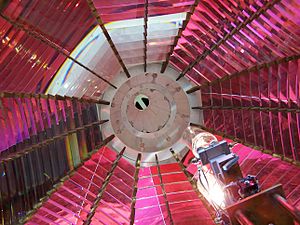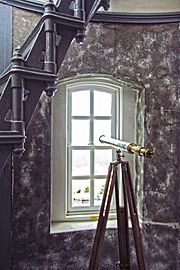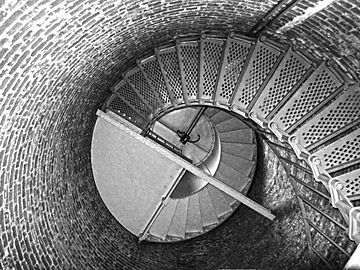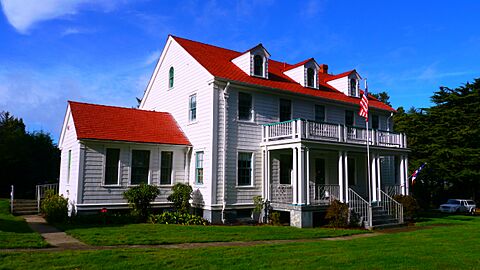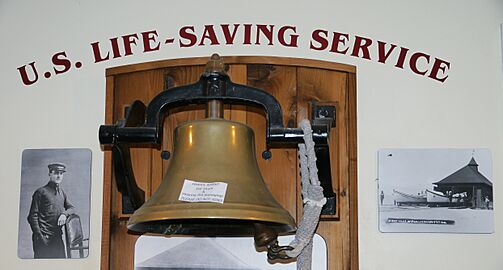Umpqua River Light facts for kids
| Location | Winchester Bay |
|---|---|
| Coordinates | 43°39′44″N 124°11′55″W / 43.662291°N 124.198476°W |
| Year first lit | 1894 |
| Automated | 1966 |
| Foundation | Natural/emplaced/masonry |
| Construction | Brick/stuccoed |
| Tower shape | Conical attached to workroom |
| Height | 61 feet (19 m) |
| Original lens | First order Fresnel |
| Range | 21 nautical miles (39 km; 24 mi) |
| Characteristic | Group Flash White, Alternate Red Flash, 15 sec. 2 W., 1 R Flashes |
The Umpqua River Light is a tall, bright lighthouse on the Oregon Coast in the United States. It stands at the mouth of the Umpqua River in Winchester Bay, Oregon. Lighthouses like this one help ships find their way safely along the coast.
Contents
History of the Umpqua River Light
The First Lighthouse
The very first Umpqua River Light was built in 1855. Its light shone for the first time in 1857. This lighthouse was placed right along the river channel. However, this spot made it unsafe from yearly floods. The floods caused the sand around the lighthouse to wash away.
By October 1863, the building's base became too weak. The entire structure soon fell apart. Even before it collapsed, the group in charge of lighthouses knew a new one would be needed. But it took until 1888 for the government to approve money for a new lighthouse.
Building the New Lighthouse
Work on the new lighthouse began in 1892. It was first lit up in 1894. This lighthouse was built using the same plans as the Heceta Head Light. Because of this, the two lighthouses look almost exactly alike.
The new Umpqua River Light was much better than the first one. It was built 100 feet (30 m) above the river. This kept it safe from any flooding. The lighthouse was also built so ships far out at sea could see its light. The first lighthouse was only helpful to ships very close to the river.
How the Light Works
The new lighthouse used a special clockwork machine to spin its Fresnel lens. This lens made the light very bright and focused. In 1966, the lighthouse became automated. This meant it no longer needed a person to operate it all the time.
The spinning machine worked for 89 years before it broke down. The Coast Guard, who now looked after the lighthouse, wanted to replace it. But many people wanted the old machine back. So, in 1985, the original machine was fixed and put back in place.
A Historic Landmark
The Umpqua River Light is an important part of history. It was added to the National Register of Historic Places in 1977. This means it is a special place worth protecting.
Visiting Today
As of August 2025, you can visit the lighthouse and a nearby museum all year. The museum is called the Coastal History Museum. It is located in an old U.S. Coast Guard building. Inside, you can learn about the lighthouse, the local area, and the Coast Guard's history on the Umpqua River.
See also
- List of lighthouses on the Oregon Coast


